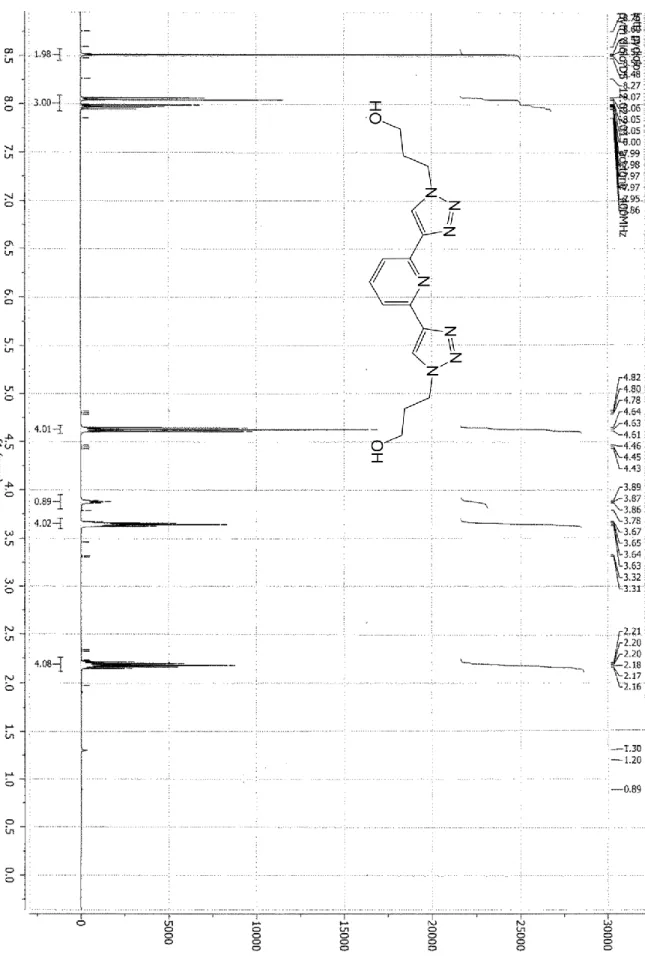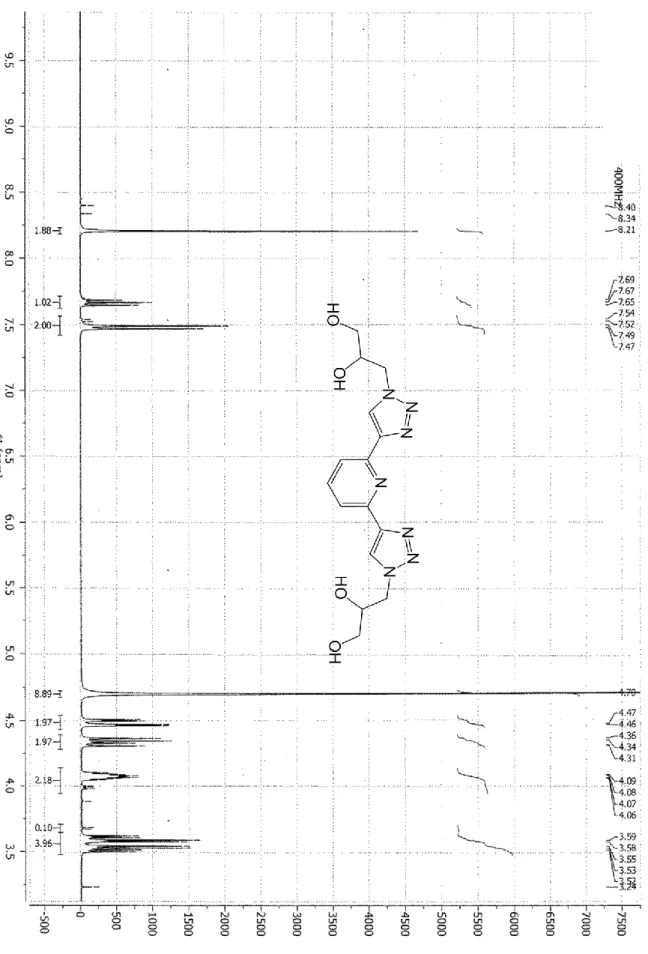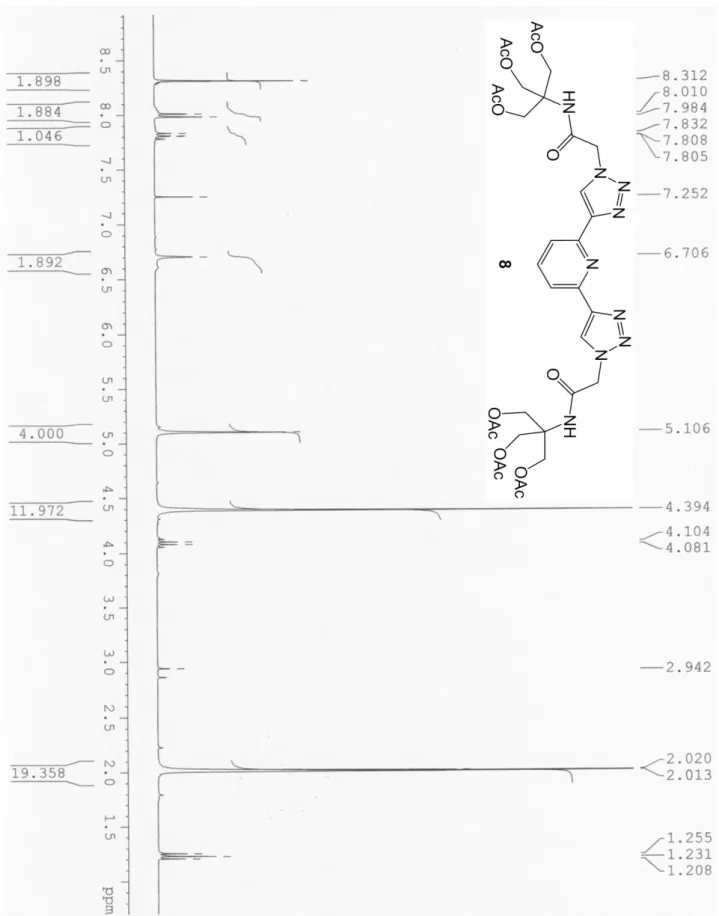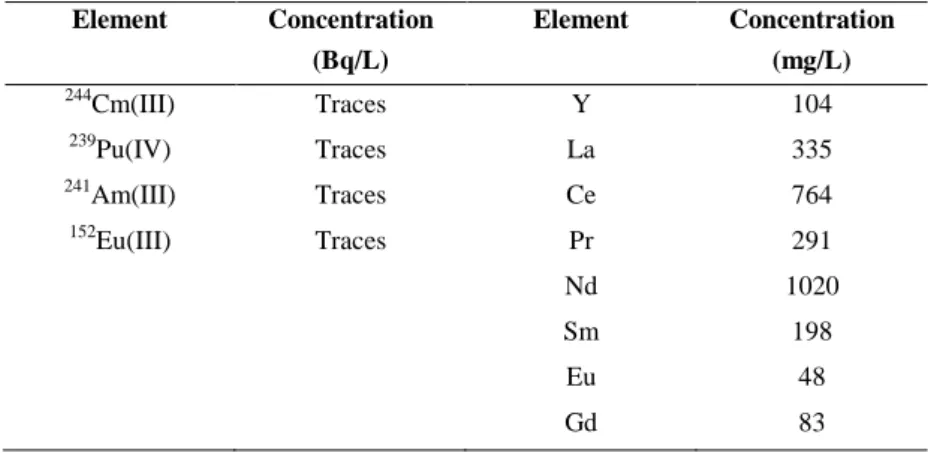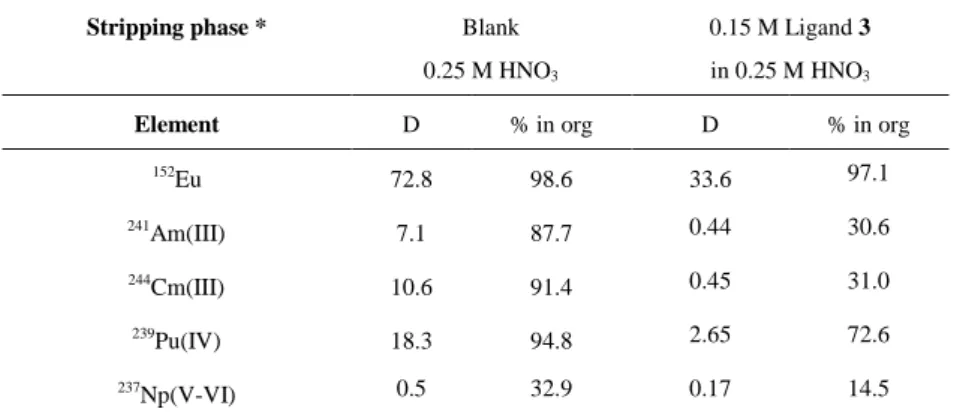HAL Id: cea-02389300
https://hal-cea.archives-ouvertes.fr/cea-02389300
Submitted on 2 Dec 2019
HAL is a multi-disciplinary open access
archive for the deposit and dissemination of
sci-entific research documents, whether they are
pub-lished or not. The documents may come from
teaching and research institutions in France or
abroad, or from public or private research centers.
L’archive ouverte pluridisciplinaire HAL, est
destinée au dépôt et à la diffusion de documents
scientifiques de niveau recherche, publiés ou non,
émanant des établissements d’enseignement et de
recherche français ou étrangers, des laboratoires
publics ou privés.
Hydrophilic Clicked 2,6-Bis-triazolyl-pyridines Endowed
with High Actinide Selectivity and Radiochemical
Stability: Toward a Closed Nuclear Fuel Cycle
Elena Macerata, Eros Mossini, Stefano Scaravaggi, Mario Mariani, Andrea
Mele, Walter Panzeri, Nathalie Boubals, Laurence Berthon, Marie-Christine
Charbonnel, Francesco Sansone, et al.
To cite this version:
Elena Macerata, Eros Mossini, Stefano Scaravaggi, Mario Mariani, Andrea Mele, et al.. Hydrophilic
Clicked 2,6-Bis-triazolyl-pyridines Endowed with High Actinide Selectivity and Radiochemical
Sta-bility: Toward a Closed Nuclear Fuel Cycle. Journal of the American Chemical Society, American
Chemical Society, 2016, 138 (23), pp.7232-7235. �10.1021/jacs.6b03106�. �cea-02389300�
Supporting Information
Hydrophilic Clicked 2,6-bis-Triazolyl-Pyridines Endowed with
high Actinide Selectivity and Radiochemical Stability: Towards a
Closed Nuclear Fuel Cycle
Elena Macerata,
a*Eros Mossini,
aStefano Scaravaggi,
aMario Mariani,
aAndrea Mele,
bNathalie Boubals,
cMarie-Christine Charbonnel,
cFrancesco Sansone,
dArturo Arduini,
dAlessandro Casnati.
d*a
Department of Energy, Politecnico di Milano,P.zza L. da Vinci 32, I-20133 Milano, Italy; Fax:
+39.02.23996309; Tel: +39.02.23996385; email:
elena.macerata@polimi.it
b
Department of Chemistry, Materials and Chemical Engineering “G. Natta”, Politecnico di Milano,
Piazza L. da Vinci, 32, 20133 Milano, Italy and CNR-ICRM, Via L. Mancinelli, 7, 20131 Milano, Italy
c
Nuclear Energy Division, RadioChemistry & Processes Department, CEA, 30207 Bagnols-sur-Cèze,
France
d
Dipartimento di Chimica, Università di Parma, Parco Area delle Scienze 17/a, 43124 Parma, Italy;
Fax: +39.0521.905472; Tel:+39.0521.905458; email:
casnati@unipr.it
Table of Contents
1
Synthetic procedures ... 3
1.1
General methods and chemicals ... 3
1.2
PyTri-Diol (1) ... 4
1.3
PyTri-Tetraol (2) ... 4
1.4
PyTri-Hexaol (3) ... 4
2
Extracting performances of the system TODGA/hydro-PyTri ... 13
2.1
Preparation of the aqueous feed ... 13
2.2
Liquid-liquid extraction protocol ... 13
2.3
Preparation of the loaded organic phase ... 14
2.4
Stripping experiments ... 14
2.5
Kinetics studies ... Erreur ! Signet non défini.
2.6
Stability studies ... 15
2.7
Stripping phase recycling ... 16
2.8
Complexation studies ... 17
1 Synthetic procedures
1.1 General methods and chemicals
Melting points were determined on an Electrothermal apparatus in capillaries sealed under nitrogen. 1H and 13C NMR spectra were recorded on Bruker AV300 and AV400 spectrometers. J coupling constants are given in Hz. Partially deuterated solvents were used as internal standards. ESI-MS spectra were recorded on a Waters single quadrupole instrument SQ Detector. TLC was performed on Merck 60 F254 silica gel and flash column chromatography on 230-400 mesh Merck 60 silica gel. Tri-O-acetylated Tris was prepared according to literature procedures.[1] All commercially available chemicals (Sigma-Aldrich) used in this study were analytical reagent grade and used without further purification. N,N,N’,N’-tetraoctyl diglycolamide (TODGA) was kindly provided by the Institute for Nuclear Waste Disposal at Karlsruhe Institute of Technology, Germany. The organic solutions were prepared by dissolving weighted quantities of TODGA in a mixture of kerosene + 5 v/v% 1-octanol.
Scheme S1
3-azido-1-propanol (5). In a round-bottomed flask NaN3 (6.13 g, 94.3 mmol) was dissolved in water (50 mL) at room
temperature. Then 3-chloro-1-propanol (5mL, 59.8 mmol) was slowly added dropwise and the reaction mixture heated at 80°C for 48 hs. After cooling, the reaction mixture was added of 50 mL of brine and 100 mL of DCM. The separated water layer was subsequently extracted twice with DCM (2x100 mL) and the organic phases combined and anhydrified over Na2SO4.
Removal of the solvent under reduced pressure gave pure compound 5 as a colourless oil showing the same physico-chemical properties as reported in the literature.[2] Yield = 85%. 1H NMR (300 MHz, CDCl3): δ = 1.76 (2H, quin, J = 6.7 Hz, N3CCH2),
3.26 (1H, s, OH), 3.37 (2H, t, J = 6.7 Hz, N3CH2) and 3.64 (2H, t, J = 6.7 Hz, CH2O).
3-azido-1,2-propandiol (6). In a round-bottomed flask NaN3 (6.2 g, 99.9 mmol) was dissolved in water (25 mL) at room
temperature. Then 3-chloro-1,2-propandiol (5mL, 59.8 mmol) was slowly added dropwise and the reaction mixture heated at 80°C for 48 hs. After cooling, the reaction mixture was added of 50 mL of brine and 100 mL of DCM. The separated water layer was subsequently extracted twice with DCM (2x100 mL) and the organic phases combined and anhydrified over Na2SO4.
Removal of the solvent under reduced pressure gave pure compound 6 as a colourless oil showing the same physico-chemical properties as reported in the literature.[3] Yield = 65%. 1H NMR (300 MHz, CDCl3): δ = 3.3-3.4 (2H, m, N3CH2), 3.56 (1H,
1.2 PyTri-Diol (1)
Samples of 2,6-diethynylpyridine 4 (0.857g, 6.7 mmol), 3-azido-1-propanol 5 (1.49 g, 14.8 mmol), sodium ascorbate (0.265 g, 1.34 mmol) and CuSO4x5H2O (0.033 g, 0.13 mmol) were dissolved in a microwave tube containing 5 mL of a t-BuOH/H2O
(4/1, v/v) mixture. The reaction mixture was irradiated at the μW (50 °C) for 1 h and subsequently the solvent removed under reduced pressure. After addition of 10 mL of acetone, the brownish inorganic salts were filtered off. The solvent was removed from the filtrate and the residue purified by flash-chromatography on silica gel (eluent gradient from DCM/MeOH = 9/1 to DCM/MeOH/Et3N = 75/15/10). Pure product 1 was collected and recrystallized from acetonitrile (1.685 g, 76%) as a yellowish
solid. 1H NMR (Acetone-D6, 400MHz, 300K, see Figure SI 1) = 8.53 (2H, s, Triaz-H), 8.05 (2H, d, J = 7.5 Hz, PyH3,5), 7.97
(1H, t, J = 7.5 Hz, PyH4), 4.63 (4H, t, J = 7.0 Hz, CH2N), 3.87 (2H, t, J = 6.5 Hz, OH), 3.64 (4H, t, J = 7.5 Hz, CH2OH), 2.20
(4H, m, J = 7.5 Hz, CH2CH2OH). 13C NMR (Acetone-D6, 100 MHz, 300K, see Figure SI 2) = 150.7 (PyC2,6), 147.8 (PyC4),
137.7 (TriazC1), 122.9 (Triaz C2), 118.2 (PyC3,5), 58.0 (CH2OH), 47.0 (CH2N), 33.1 (CH2CH2OH). ESI-MS (+): 352.5
[M+Na]+.
1.3 PyTri-Tetraol (2)
Samples of 2,6-diethynylpyridine 4 (0.40g, 3.2 mmol), 3-azido-1,2-propandiol 6 (0.82 g, 7.0 mmol), sodium ascorbate (0.125 g, 0.63 mmol) and CuSO4x5H2O (0.016 g, 0.06 mmol) were dissolved in a microwave tube containing 5 mL of a t-BuOH/H2O
(4/1, v/v) mixture. The reaction mixture was irradiated at the μW (50 °C) for 1 h and subsequently the solvent removed under reduced pressure. After addition of 10 mL of a MeOH/DCM (1/1, v/v) solution, the brownish inorganic salts were filtered off. The solvents were removed from the filtrate and the residue purified by flash-chromatography on silica gel (eluent gradient from DCM/MeOH = 9/1 to DCM/MeOH/Et3N = 75/15/10). Pure product 2 (0.936 g, 82%) was obtained as a yellowish solid. 1
H NMR (D2O, 400MHz, 300K, see Figure SI 3) = 8.21 (2H, s, Triaz-H), 7.67 (1H, t, J = 7.5 Hz, PyH4), 7.48 (2H, d, J = 7.5
Hz, PyH3,5), 4.47 (2H, dd, J = 14.4, 3.6 Hz Hz, CH2CO), 4.34 (2H, dd, J = 14.4, 8.0 Hz, CH2O), 4.07 (2H, m, CH), 3.57 (2H,
dd, J = 12.0, 4.8 Hz, CH2O), 3.52 (2H, dd, J = 12.0, 4.8 Hz, CH2O). 13C NMR (CD3OD, 100MHz, 300K, see Figure SI 4) =
149.9 (PyC2,6), 147.5 (PyC4), 137.8 (TriazC1), 124.3 (TriazC2), 118.6 (PyC3,5), 70.6 (CHOH), 63.2 (CH2OH), 53.1 (CH2N).
ESI-MS (+): 384.3 [M+Na]+.
1.4 PyTri-Hexaol (3)
Samples of 2,6-diethynylpyridine 4 (0.240g, 1.9 mmol), 2-azido-acetamide 7 (1.45 g, 4.40 mmol), sodium ascorbate (0.133 g, 0.67 mmol) and CuSO4x5H2O (0.014 g, 0.06 mmol) were dissolved in round-bottomed flask containing 40 mL of a DMF/H2O
(2/1, v/v) mixture. The reaction mixture was stirred at rt for 48 hs and subsequently the solvents removed under reduced pressure. The product was then purified by flash-chromatography on silica gel (eluent gradient from DCM/MeOH = 9/1) to give the pure product 8 (1.165 g, 75%) of a yellowish solid (mp = 46-47 °C). 1H NMR (CDCl3, 300MHz, 300K, see Figure SI
5) = 8.31 (2H, s, Triaz-H), 7.99 (2H, d, J = 7.5 Hz, PyH), 7.80 (1H, t, J = 7.5 Hz, PyH), 6.70 (1H, s, NH), 5.10 (4H, s, CH2CO), 4.39 (12H, s, CH2O), 2.02 (18H, s, COCH3).
13
C NMR (CDCl3, 75MHz, 300K, see Figure SI 6) = 170.5 (CH3C=O),
165.5 (NC=O),149.5 (PyC2,6), 148.6 (PyC4), 137.7 (TriazC1,2), 124.2 (TriazC2), 119.2 (PyC3,5), 62.3 (C(CH2OH)3), 58.4
(C(CH2OH)3), 53.2 (NCH2CO), 20.7 (CH3CO). ESI-MS (+): 810.5 [M+Na]+.
A sample of compound 8 (0.630 g, 0.800 mmol) was dissolved in methanol (50 mL) and added of solid CH3ONa (12.5 mg).
The reaction mixture was stirred at rt for 40 min. Then Amberlite IR120 was added till the solution reached pH = 7. The solution was separated, the resin washed with methanol and the filtrates collected. The crude product was submitted to flash column chromatography on silica gel (eluent EtAcetate/iso-PrOH/H2O = 7/3/0.5) to give the pure product 3 (0.200 g, 47%) as
a yellowish solid (mp = 59-61 °C). 1H NMR (CD3OD, 300MHz, 300K, see Figure SI 7) = 8.53 (2H, s, Triaz-H), 7.87-7.85
(3H, m, PyH), 5.30 (4H, s, CH2CO), 3.80 (12H, s, CH2O). 13C NMR (CD3OD, 75MHz, 300K, see Figure SI 8) = 168.3
(C=O), 151.0 (PyC2,6), 149.1 (PyC4), 139.2 (TriazC1), 126.5 (TriazC2), 120.1 (PyC3,5), 64.2 (C(CH2OH)3), 62.0 (C(CH2OH)3),
Figure SI 4
Figure SI 5
Figure SI 6
Figure SI 7
Figure SI 8
2 Extracting performances of the system TODGA/hydro-PyTri
The hydrophilic ligands 1-3 were designed for the application in the i-SANEX or GANEX-2 processes, that are intended to take place downstream of the PUREX or GANEX-1 processes respectively. For this purpose, the ligands should be able to selectively separate actinides (An) from a TODGA-based organic phase containing also trivalent lanthanides (Ln(III)). Figure S9 reports the molecular structure of the highly efficient N,N,N’,N’-tetraoctyl diglycolamide, named TODGA.
Figure S9 Molecular structure of N,N,N’,N’-tetraoctyl diglycolamide (TODGA).
Therefore, the extracting properties of hydro-PyTri were extensively studied in experimental conditions of interest for the nuclear reprocessing application by means of traced liquid-liquid extraction tests.
2.1 Preparation of the aqueous feed
For experimental/operational requirements, two different aqueous feeds were used in the extraction tests simulating the solutions to be decontaminated. A first solution, named i-SANEX FEED, was prepared by dissolving inactive Y and lanthanides (from La to Gd) nitrate salts in 3 M HNO3 solution and by adding 241Am and 152Eu in trace concentrations
(approximately 10000 Bq/g of each tracer). A second solution, named GANEX FEED, containing trace amounts of 244Cm(III) and 239Pu(IV), in addition to 241Am(III),152Eu, Y and Ln (from La to Gd) was prepared. The compositions of the two feeds are shown in Table S1.
Table S1 Composition of the simulated i-SANEX and GANEX FEED solutions used in the extraction experiments.
Element Concentration (Bq/L) Element Concentration (mg/L) 244 Cm(III) Traces Y 104 239 Pu(IV) Traces La 335 241 Am(III) Traces Ce 764 152 Eu(III) Traces Pr 291 Nd 1020 Sm 198 Eu 48 Gd 83
2.2 Liquid-liquid extraction protocol
The liquid-liquid extraction tests were performed following a standard protocol. Equal volumes of aqueous and organic phases were contacted in closed single-use Eppendorf microtubes at room temperature (T = 22 ± 2 °C). Once contacted, the organic and aqueous phases were vigorously shaken with a benchtop shaker for 1h. The mixing time of 1h was found to be enough for the system to reach the equilibrium. After the phases separation by centrifugation, an aliquot of 200 μL from each phase was subsampled and analysed. The 241Am and 152Eu specific activities were quantified by γ spectrometry (2”x2” NaI(Tl), Silena SNIP 201 N MCA) exploiting the γ lines at 59.5 keV and 121.8 keV, respectively. The 239Pu and 244Cm specific activities were
quantified by α spectrometry. The concentrations of stable elements (Y and lanthanides) were determined by Inductively Coupled Plasma Mass Spectrometry (ThermoFisher X-SeriesII ICP-MS) as direct measurements on the aqueous phases after
is described by the distribution coefficients, DM, defined as the ratio between the radioisotope activity or the element
concentration in the organic phase and that in the aqueous one. The selectivity for Ln over Am is expressed by the separation factor, SFLn/Am, defined as the ratio of distribution coefficients DLn/DAm. The activity balance was checked and the overall
accuracy in the determination of DM is within few percent.
2.3 Preparation of the loaded organic phase
This extraction step simulates the first step of the i-SANEX process or GANEX-2 process. An and Ln are co-extracted into the organic phase, while the other fission and corrosion products remain in the aqueous phase. Thus, the loaded organic phase was used as phase to be decontaminated in the following stripping tests.
Extraction experiments were performed by contacting a 0.2 M TODGA solution in kerosene + 5 v/v% 1-octanol with an equal volume of a 3 M nitric acid aqueous feed. The lipophilic extractant TODGA is able to co-extract 99.9% of An and Ln present in the aqueous phase into the organic one. The cations concentration in the loaded organic phase was then determined by ICP-MS, α and spectrometry. Moreover, it is known that TODGA is able to extract nitric acid, that is subsequently released when contacted with aqueous solutions at lower acidity. This phenomenon has an impact on the equilibrium acidity of the stripping phase, that is an important parameter in the extraction process. Therefore it was monitored (checked?) in the different steps of the experiments by potentiometric titration.
2.4 Stripping experiments
The stripping experiments consisted in contacting the loaded TODGA-based solutions with the aqueous stripping phases, that are ligand 1-3 solutions in 0.25 M HNO3. To specifically investigate the role of the hydrophilic ligands, stripping experiments
with 0.25 M HNO3 in absence of the hydrophilic ligands were performed and reported as blank experiments. First of all, the
solubility of the hydrophilic extractants in the aqueous phase was ascertained by a stepwise process: a weighted quantity of compound was dissolved in diluted nitric acid solution and weighted amounts of diluent were added until the solutions were clear. Then, the losses of ligands due to their solubility in the organic phase (kerosene + 5 v/v% 1-octanol or 0.2 M TODGA in kerosene + 5 v/v% 1-octanol) were evaluated by UV-VIS measurements of the ligand concentration. For both the ligands, a concentration variation within the experimental error was observed (or not observed? I do not understand if there is some lost of ligand or not). Consequently no pre-equilibration of the phases before the tests was carried out. In addition, the amount of HNO3 released into the aqueous phase during the stripping step was evaluated by measuring the HNO3 concentration before
(initial) and after (equilibrium) the test (equilibrium) by means of potentiometric titration with NaOH. The HNO3
concentration, initially at 0.25 M, reached the equilibrium value at 0.44 M after the contact with the loaded organic phase. Some extraction tests were performed with 0.44 M HNO3 stripping phases because the stripping test is preceded with a
scrubbing step by 0.5 M HNO3. During this stage the extracted nitric acid is released, so that no acidity changes were
registered in the following stripping step. Table S2 shows the distribution coefficients and the SF values for Eu and some An back-extracted by ligands 1 and 2.
Further stripping experiments were performed on organic phases loaded with 241Am(III), 244Cm(III), 239Pu(IV), 237Np(V-VI),
152Eu, stable Y and Ln (from La to Gd). As reported in Table S3, with the exception of Np, in absence of ligands only a small
percentage of the cations is back extracted in 0.25 M nitric acid. The introduction of the hydrophilic PyTri ligands in the aqueous phase considerably increases the An stripping. All the ligands 1-3 show an impressive selectivity for An, in fact the DAm, DCm and DPu values decrease of about two orders of magnitude, while those of Eu are decreased to a much lower extent.
These results highlight the ability of these ligands to co-extract actinides in different oxidation states, a characteristic essential for the GANEX application, even if with different extraction efficiencies. Ligands 1 and 2 manifest a quite similar behavior. Ligand 3, despite of its higher water solubility, always shows lower selectivity for An both in i-SANEX and GANEX conditions, indicating that the presence of the hard amide carbonyl groups might interfere with the separation process.
Table S2 DM and SF values for the stripping of Am3+, Cm3+ and Pu4+ from a TODGA-based organic phase into a PyTri-based
aqueous solution.
Stripping
phasea, b Blank 0.08M Ligand 1 0.15M Ligand 2
Element D % in org D % in org D % in org 152 Eu 53.7 98.2 14.2 93.4 14.2 93.4 241 Am(III) 6.4 86.5 0.06 5.3 0.06 5.8 244 Cm(III) 7.6 88.4 0.04 4.1 0.06 6.0 239 Pu(IV) 11.7 92.1 0.08 7.8 0.05 4.5 SFEu/Am 8.4 237 237 SFEu/Pu 4.6 178 284 a in 0.44 M HNO3 solution. b
Organic phase in the stripping tests: 0.2 M TODGA in kerosene/1-octanol (95/5 v/v) loaded with GANEX feed and scrubbed with 0.5 M HNO3
Table S3 DM values for the stripping of Am 3+
, Cm3+, Pu4+ and Np5+/6+ from a TODGA-based organic phase into a PyTri-based aqueous solution.
Organic phase: 0.2 M TODGA in kerosene +5 v/v% 1-octanol loaded with GANEX FEED
Stripping phase * Blank
0.25 M HNO3
0.15 M Ligand 3 in 0.25 M HNO3
Element D % in org D % in org
152 Eu 72.8 98.6 33.6 97.1 241 Am(III) 7.1 87.7 0.44 30.6 244 Cm(III) 10.6 91.4 0.45 31.0 239Pu(IV) 18.3 94.8 2.65 72.6 237Np(V-VI) 0.5 32.9 0.17 14.5
* the reported HNO3 concentration is the initial concentration in the aqueous stripping solution.
In order to assess the stripping kinetics, the organic phase (0.2 M TODGA in kerosene +5 v/v% 1-octanol) loaded from the i-SANEX FEED and the PyTri-based stripping phases (0.08 M Ligand 1 in 0.25 M HNO3 and 0.15 M Ligand 2 in 0.25 M
HNO3) were shaken for different times from 5 to 60 minutes. The stripping kinetics proved to be fast since the distribution
coefficients of both ligands are at equilibrium within 5 minutes.
2.5 Stability studies
With the purpose of understanding the radiolytic behaviour of the novel stripping solutions, the samples were irradiated prior to suitable analyses. The main contribution to radiolysis comes from alpha emitters, however, The irradiations were performed by two 60Co gamma sources, characterised by different dose rates (high dose rate: 2.5 kGy/h, low dose rate: 0.13 kGy/h) at absorbed doses up to 200 kGy. The irradiations were performed in air in glass vials closed with a plastic lid keeping the samples in the dark at room temperature (22 ± 1°C). At the end of the irradiation, the irradiated solutions were stored at 4 ± 1°C until further analysis. Unirradiated samples, with same ageing and thermal treatment of the irradiated samples, were
function of the absorbed dose. The distribution coefficients are almost constant in the range of absorbed dose considered for ligand 1, while in the case of ligand 2 they show a slight decrease for absorbed doses higher than 100 kGy.
Figure S10 Distribution coefficients and separation factors for ligand 1 (left) and 2 (right) stripping solutions as a function of the absorbed dose. Organic phase: 0.2 M TODGA in kerosene/1-octanol (95/5 v/v) loaded with GANEX FEED; Aqueous phase: irradiated 0.08 M of ligand 1 or 0.15 M of ligand 2, [HNO3]in =0.44 M (dose rate = 2.5 kGy/h).
Besides stripping experiments with irradiated ligand solutions, the radiolytic stability of ligand 1 was studied by means of several analytical techniques. In particular, the HPLC-DAD experiments were performed after mobile phase optimisation, verification of repeatability and calibration with solutions containing different ligand concentration. Figure S11 compares the HPLC chromatograms of a fresh 0.08 M 1 solution in 0.44 M HNO3 with one irradiated at 200 kGy with 2.5 kGy/h.
Figure S11 HPLC chromatograms of 1 solutions in 0.44 M HNO3 irradiated up to 200 kGy (2.5 kGy/h).
The ESI-MS and tandem MS experiments highlighted the presence in the irradiated solutions of species with m/z ratios in some cases lower than that of the proton adduct of the ligand 1, coherent with the loss of a lateral chain, and in other cases higher than that of [1-H] +, coherent with the addition of radical species from diluent radiolysis.
2.6 Stripping phase recycling
A recycling step of the aqueous stripping phases was optimised. 241Am and 152Eu traced batch experiments showed that the cations complexed with 1 could be removed by re-extraction with a fresh TODGA-based solution. The concentration of nitric acid in the aqueous phase and of TODGA in the organic phase were optimised in order to achieve a satisfying cleaning of the stripping solution. An organic phase consisting of 0.2 M TODGA in kerosene + 5 v/v% 1-octanol proved to be able to decontaminate the loaded stripping solution, whose acidity was set to 1 M nitric acid, with DAm = 28.0 and DEu > 1000
2.7 Complexation studies
The extraction mechanism of 1 was studied by performing extraction experiments at different concentrations of 1 in 0.44 M HNO3 and TODGA phases loaded with 241Am and 152Eu and scrubbed with 0.5 M HNO3. The preliminary results are reported
in Figure S12. LogD vs. Log[1] plot shows slopes of 1.5 and 0.5 for the extraction of Am(III) and Eu(III) salts, respectively, suggesting the presence of different species. In particular, both 1:1 and 1:2 (M:L) complexes were observed for Am(III), while for Eu(III) only the 1:1 complex seems to be present.
Figure S12 Distribution ratios for Am(III) and Eu(III) as a function of [1]. Organic phase: 0.2 M TODGA in kerosene + 5 v/v% 1-octanol loaded with 241Am and 152Eu and scrubbed with 0.5 M HNO3; Aqueous phase: 1 in 0.44 M HNO3.
Further information about complexes stoichiometry were obtained by ESI-MS measurements. Samples were prepared by adding 1 or 2 ligand solution in 0.25 M HNO3 to Eu(NO3)3 solution in 0.25 M HNO3 at different cL/cEu ratios (0.1, 1, 2 and 10).
Samples were suitably diluted with pure CH3CN before analysis. For both the ligands, several peaks were detected for Eu
complexes having stoichiometry ligand:cation:anion (M:L:A) 1:2:x (x = 0-2) and 1:1:x (x = 1-2). A selection of Am(III) solutions prepared to the UV-vis study (cL/cAm = 0.1 and 10) were diluted in CH3CN before analysis. Electropstray ionization
mass spectra of americium –ligand solution are presented figure S13 as example. Under these conditions, complexes having M:L:A with 1:3:x (x = 0, 1) ; 1:2:x (x = 0-2) were detected for both ligand and a 1:1:2 species was detected for 1 ligand suggesting a stronger interaction of ligands 1 and 2 with Am(III) compared to Eu(III). Even though the counteranion used in the two experiments (chloride vs. nitrate) could play a role, the outcomes collected seem to indicate that Am complexes exhibit higher stoichiometry compared to those observed for Eu, coherently result consistent with the extraction data.
The coordination compounds were further studied by UV-VISvis titrations of ligand solutions with Am, Pu and Eu, in order to compute the stability constants. Stability constants of Eu(III) complexes with ligands 1 and 2 were determined by analysis of UV-vis spectra registred at 25 °C between 280-340 nm. A series of solutions were prepared in MeOH/H2O 75:25 (v/v) in the
range cligand/cEu = 0.01 to 6 with the mothers solutions EuCl3 in H2O, ligand in H2O and MeOH. Stability constants of Am(III)
complexes with ligands 1 and 2 were determined by analysis of UV-vis spectra registred at 25 °C between 450 and 550 nm. A series of solutions were prepared in MeOH/H2O 75:25 (v/v) in the range cligand/cAm = 0 to 20 with the mothers solutions AmCl3
acidity ≈ 0.5M and avoid hydrolysis of Pu(IV). The signal was monitored in the spectral region 460-570 nm. Due to the acidity of the medium, the Pu logβ1:1 values were corrected by the ligand protonation constant (pKa = 2.1 with ligand 1). The recorded
spectrophotometric data were processed by HypSpec software.
Figure S133: ESI-MS spectra of Am(III) ligand species in MeOH/H2O 75:25 (v/v). cligand/cEu = 10. Zoom in the 400-1050
m/z. Top: Am-2 ligand solution and bottom Am-1 ligand solution.
3 References
(1) Scaravaggi, S.; Macerata, E.; Galletta, M.; Mossini, E.; Casnati, A.; Anselmi, M.; Sansone, F.; Mariani, M. J. Radioanal. Nucl. Chem. 2015, 303, 1811-1820.
(2) Antoni, P.; Hed, Y.; Nordberg, A.; Nystrom, D.; von Holst, H.; Hult, A.; Malkoch, M. Angew. Chem. 2009, 48, 2126-2130.
(3) Thota, B. N.; Berlepsch, H. V.; Boettcher, C.; Haag, R. Chem. Commun. 2015, 51, 8648-8651.
441.50 481.16 561.74 661.77 679.73 745.33 797.28 919.19 997.36 juin0082.d: +MS 409.56 449.20 467.18 519.28 584.79 613.77 631.78 681.35 733.35 749.30 791.32 869.43 933.41 969.43 996.42 juin0092.d: +MS 0.0 0.5 1.0 1.5 5 x10 Intens. 0 2 4 6 4 x10 400 500 600 700 800 900 1000 m/z AmL 3 3+ AmL 3 3+ AmL 2Cl 2+ AmL 2Cl 2+ AmL 2H-1 2+ AmL 2H-1 2+ AmL 3H-1 2+ AmL 3Cl 2+ AmL 2Cl2 + AmL 2Cl2 + AmL 2H-1Cl + AmL 2H-1Cl + AmL 3H-1 2+ AmL 3Cl 2+ L2Na+ L 2CaCl + L 2CaCl +
